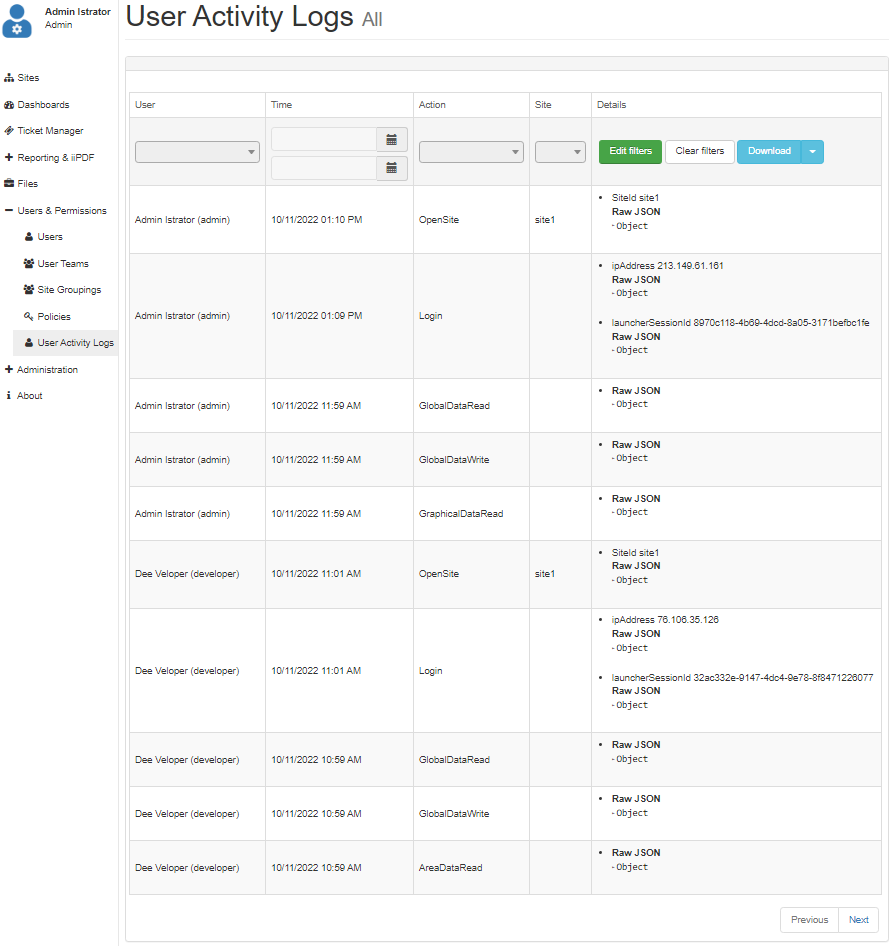4.3.2.3. User Activity Logs
The User Activity Logs Global Console menu displays information about user activity in IRM, which is useful as an audit trail. Tracked activities include logging into the system, opening Sites, adding additional Users, etc. User actions are displayed in a paginated data grid, generally similar to ones in the Report and iiPDF Export pages.
The User Activity Logs mechanism is useful as it captures any user activities that occured upon and after a Site is opened. The information is recorded at the granularity of one minute, and includes which Areas were accessed and whether anything was written or not (read-write vs. read-only). The application keeps a few simple pieces of data for each user accessing the system, like which Areas the user is getting data from (including any Design World data) and whether the user wrote any data in that Area.
Note: If the user operates the Web Client in such a fashion that no data is read from or written to the server, no activity will be indicated in the log. However, using IRM in any significant way without generating read or write transactions is very unlikely and not a common use case.
An example screenshot User Activity Logs Global Console page is displayed below, followed with text breaking down its main properties and specifics:

The column data displays the following information for each user activity:
-
username of the person performing the action
-
the date and time of the activity
-
the type of activity that was performed, which can be one of the following:
-
Login, Open Site, Admin Change, Data Export, Area Export, Elevation Export, Report View, Report Download, File Download
-
Graphical Data Read - the user reads quadrants associated with a particular Area, like Equipment, Cable, or Location
-
Area Data Read - the user reads instance objects associated with a particular Area, like Equipment, Cable, or Location
-
Area Data Write - the user wrote instance objects associated with a particular Area, like Equipment, Cable, or Location
-
Global Data Read - the user reads objects not associated with any particular Area, like User or Contract
-
Global Data Write - the user wrote objects not associated with any particular Area, like User or Contract
-
the IRM Site the action was performed on
-
additional data that describes the action more specifically, in most cases displayed as a string in JSON format with its contents depending on the type of action
-
for example, for the Login action the IP Address of the User is recorded
Notice that each column allows filtering data, with the exception of the Details column, which displays the filter controls:

 - clicking on the Download button downloads all the User Log data displayed in the data grid in a .csv file, while the drop-down button option downloads the Data Log without the metadata (Details column), which can be considered an abbreviated version of the User Log.
- clicking on the Download button downloads all the User Log data displayed in the data grid in a .csv file, while the drop-down button option downloads the Data Log without the metadata (Details column), which can be considered an abbreviated version of the User Log.Generally, there are two uses for User Activity Logs:
-
casual investigations, like
-
"Did Joe log into the system today?"
-
"Which areas did Sarah access?"
-
detailed forensic investigations
-
exactly which objects a user accessed
-
did the user write this specific object
While the User Log interface is very convenient and informative for the former case, we recommend downloading the full User Log for the latter use.